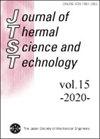生物质挥发初级焦油产率的定量分析(加热速率和生物质类型对焦油成分的影响)
IF 0.9
4区 工程技术
Q3 THERMODYNAMICS
引用次数: 2
摘要
虽然快速热解的挥发分产率高于慢速热解,但不同升温速率下组分产率的变化尚未见详细报道。此外,很少有研究评估焦油组分产率随生物量类型的变化。因此,本研究从实际的角度出发,通过气相色谱-质谱法定量测定了加热速率和生物质类型对焦油组分产率的影响。此外,还对沥青的形成机理进行了探讨。主要研究结果如下:(1)定量确定了升温速率增加100倍后生物质焦油产率和组分的变化。加热速率的增加导致芳香化合物的产量增加,并诱导苯、甲苯和其他化合物的形成。在缓慢加热速率下,香兰素、糠醛、酸和醛等气味成分的产量增加。在中等升温速率(1.0 K/s)下,含OH和O基团的酚类含量显著增加。(2)对于木质生物质,乙酸、纤维素衍生的葡萄糖、儿茶酚、酚类和糠醛被确定为主要焦油成分。(3)树干、树皮和草中挥发的焦油组分受生物质组分主要含量的影响。本文章由计算机程序翻译,如有差异,请以英文原文为准。
Quantitative analysis of primary tar yields volatilized from biomass (Effect of heating rate and biomass type on tar components)
Although rapid pyrolysis affords higher volatile yield than slow pyrolysis, the change in the yield of components at different heating rates have not been reported in detail. Moreover, few studies have assessed the changes in the tar component yield with respect to biomass type. Therefore, from a practical point of view, this study quantitatively determined the effects of the heating rate and biomass type on the tar component yield through gas chromatography–mass spectrometry. In addition, the mechanism of tar formation was investigated. The main results of the study are as follows: (1) Changes in the yield and component of biomass tar due to increase in the heating rate by a factor of 100 were quantitatively determined. An increased heating rate resulted in a higher yield of aromatic compounds and induced the formation of benzene, toluene, and other compounds. At slow heating rates, the yield of odorous components such as vanillin, furfural, acids, and aldehydes increased. At the middle heating rate (1.0 K/s), a significant increase in the amount of phenols containing OH and O groups was observed. (2) For woody biomass, acetic acid, cellulose-derived glucose, catechol, phenols, and furfural were identified as the major tar components. (3) The tar components volatilized from the wood trunk, bark, and grass are affected by the primary content of the biomass constituents.
求助全文
通过发布文献求助,成功后即可免费获取论文全文。
去求助
来源期刊
CiteScore
2.30
自引率
8.30%
发文量
0
审稿时长
5 months
期刊介绍:
JTST covers a variety of fields in thermal engineering including heat and mass transfer, thermodynamics, combustion, bio-heat transfer, micro- and macro-scale transport phenomena and practical thermal problems in industrial applications.

 求助内容:
求助内容: 应助结果提醒方式:
应助结果提醒方式:


